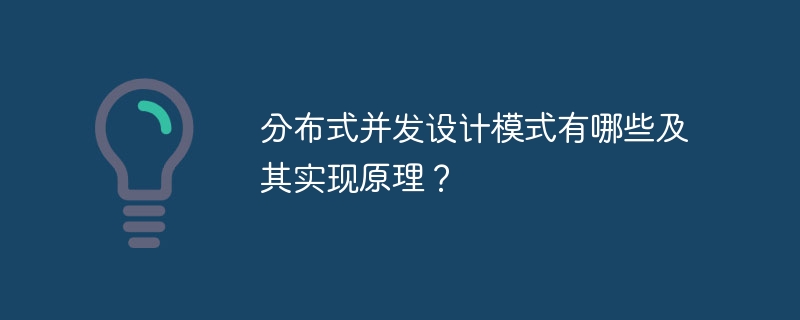
分布式并发设计模式详解
在分布式开发中,除了常规的23种设计模式外,还有一些针对并发场景的常用设计模式,本文将对这些模式进行详细介绍。
1. 单例模式(singleton)
原理:

LimeSurvey是一款在线问卷管理系统,具有问卷的设计、修改、发布、回收和统计等多项功能。同时它也是一个开源软件,其最新版本的软件包可以完全免费获取和使用。它集成了调查程序开发、调查问卷的发布以及数据收集等功能,使用它,用户不必了解这些功能的编程细节。 网上收集的调查数据可以导出多种文件格式以便分析,例如 spss数据格式 *.dat文件。
 198
198

并发代码示例:
public class singleton {
private static volatile singleton instance;
private singleton() {
// 私有构造函数
}
public static singleton getinstance() {
if (instance == null) { // 第一次检查
synchronized (singleton.class) { // 同步锁
if (instance == null) { // 第二次检查
instance = new singleton();
}
}
}
return instance;
}
}2. 不可变对象模式(immutable object)
原理:
并发代码示例:
public final class immutableperson {
private final string name;
private final int age;
public immutableperson(string name, int age) {
this.name = name;
this.age = age;
}
public string getname() {
return name;
}
public int getage() {
return age;
}
public immutableperson setname(string newname) {
return new immutableperson(newname, age);
}
public immutableperson setage(int newage) {
return new immutableperson(name, newage);
}
}3. 线程局部存储模式(thread local storage)
原理:
并发代码示例:
public class threadlocalexample {
// 定义一个threadlocal变量,用于存储线程级别的变量
private static final threadlocal<string> threadlocal = new threadlocal<string>();
public static void setthreadlocalvalue(string value) {
threadlocal.set(value);
}
public static string getthreadlocalvalue() {
return threadlocal.get();
}
public static void main(string[] args) {
// 在主线程中设置和获取threadlocal变量的值
setthreadlocalvalue("main thread value");
system.out.println("main thread value: " + getthreadlocalvalue());
// 创建一个新线程并设置和获取threadlocal变量的值
thread thread = new thread(() -> {
setthreadlocalvalue("child thread value");
system.out.println("child thread value: " + getthreadlocalvalue());
});
thread.start();
}
}4. 生产者-消费者模式(producer-consumer)
原理:
并发代码示例:
import java.util.concurrent.blockingqueue;
import java.util.concurrent.linkedblockingqueue;
class producer implements runnable {
private final blockingqueue<integer> queue;
public producer(blockingqueue<integer> q) {
queue = q;
}
public void run() {
try {
for (int i = 0; i < 10; i++) {
queue.put(i);
system.out.println("produced: " + i);
}
} catch (interruptedexception ex) {
ex.printstacktrace();
}
}
}
class consumer implements runnable {
private final blockingqueue<integer> queue;
public consumer(blockingqueue<integer> q) {
queue = q;
}
public void run() {
try {
while (true) {
int value = queue.take();
system.out.println("consumed: " + value);
}
} catch (interruptedexception ex) {
ex.printstacktrace();
}
}
}
public class producerconsumerexample {
public static void main(string[] args) {
blockingqueue<integer> queue = new linkedblockingqueue<integer>(10);
producer producer = new producer(queue);
consumer consumer = new consumer(queue);
new thread(producer).start();
new thread(consumer).start();
}
}5. 读者-写者模式(read-write lock)
原理:
并发代码示例:
import java.util.concurrent.locks.readwritelock;
import java.util.concurrent.locks.reentrantreadwritelock;
class sharedresource {
private final readwritelock readwritelock = new reentrantreadwritelock();
private final lock readlock = readwritelock.readlock();
private final lock writelock = readwritelock.writelock();
private string data;
public void read() {
readlock.lock();
try {
// 读取数据
system.out.println("reading data: " + data);
} finally {
readlock.unlock();
}
}
public void write(string newdata) {
writelock.lock();
try {
// 写入数据
data = newdata;
system.out.println("writing data: " + data);
} finally {
writelock.unlock();
}
}
}
public class readwritelockexample {
public static void main(string[] args) {
sharedresource resource = new sharedresource();
// 创建多个读者线程
for (int i = 0; i < 5; i++) {
new thread(resource::read).start();
}
// 创建写者线程
new thread(() -> resource.write("new data")).start();
}
}6. 工作队列模式(worker thread)
原理:
import java.util.concurrent.ExecutorService;
import java.util.concurrent.Executors;
import java.util.concurrent.TimeUnit;
class Task implements Runnable {
private final int taskId;
public Task(int taskId) {
this.taskId = taskId;
}
@Override
public void run() {以上就是分布式并发设计模式有哪些及其实现原理?的详细内容,更多请关注php中文网其它相关文章!

每个人都需要一台速度更快、更稳定的 PC。随着时间的推移,垃圾文件、旧注册表数据和不必要的后台进程会占用资源并降低性能。幸运的是,许多工具可以让 Windows 保持平稳运行。

Copyright 2014-2025 https://www.php.cn/ All Rights Reserved | php.cn | 湘ICP备2023035733号